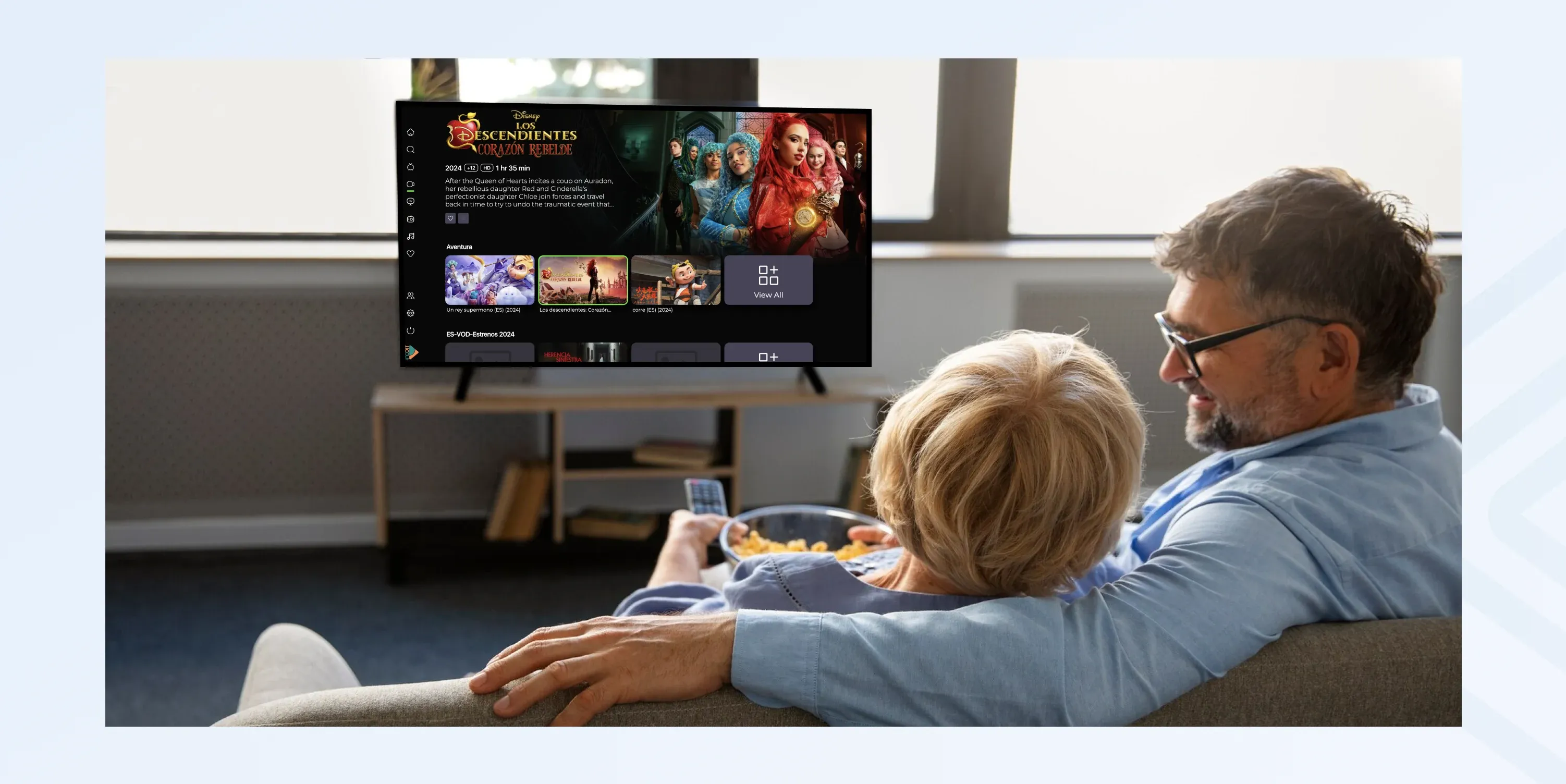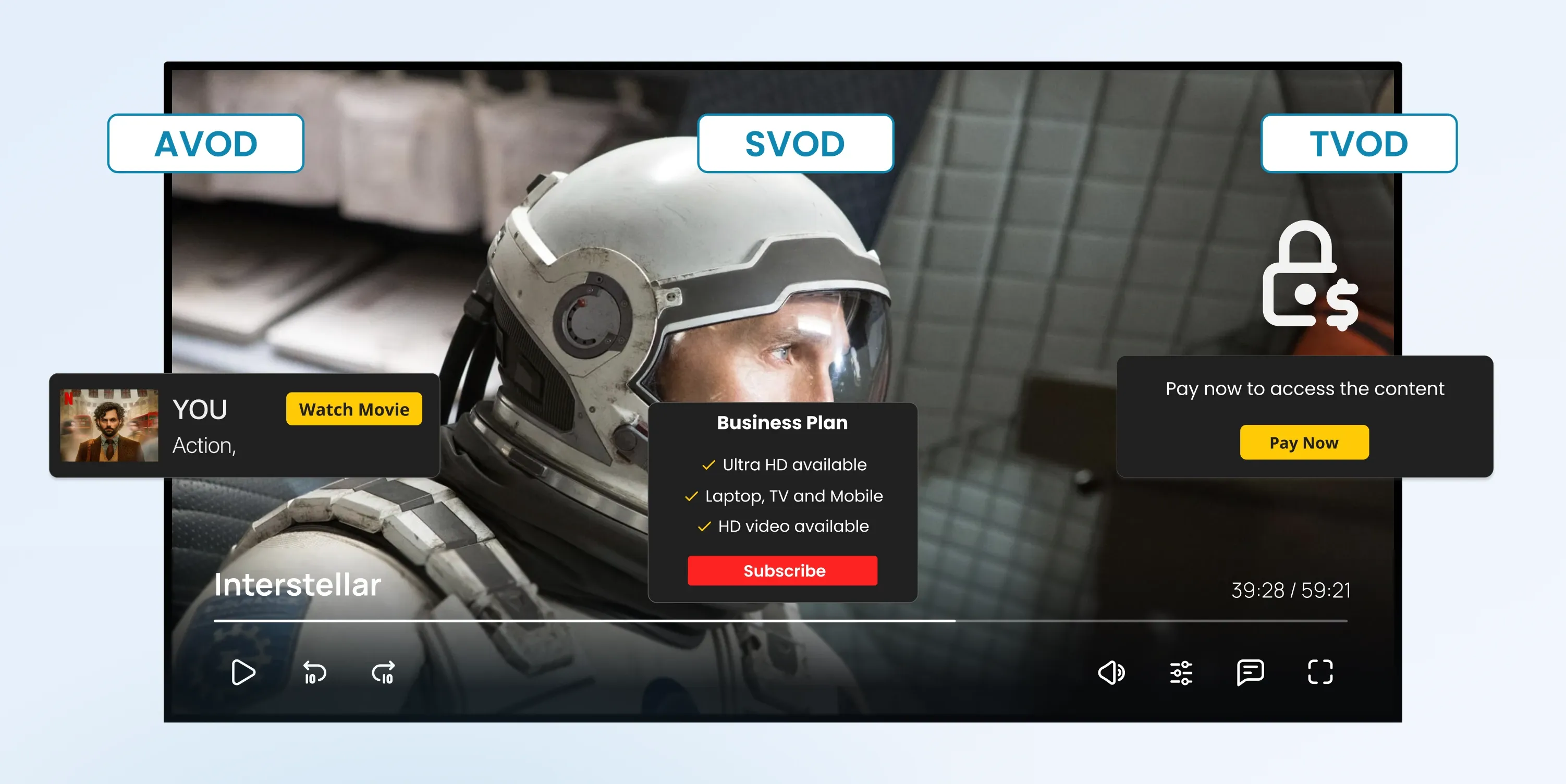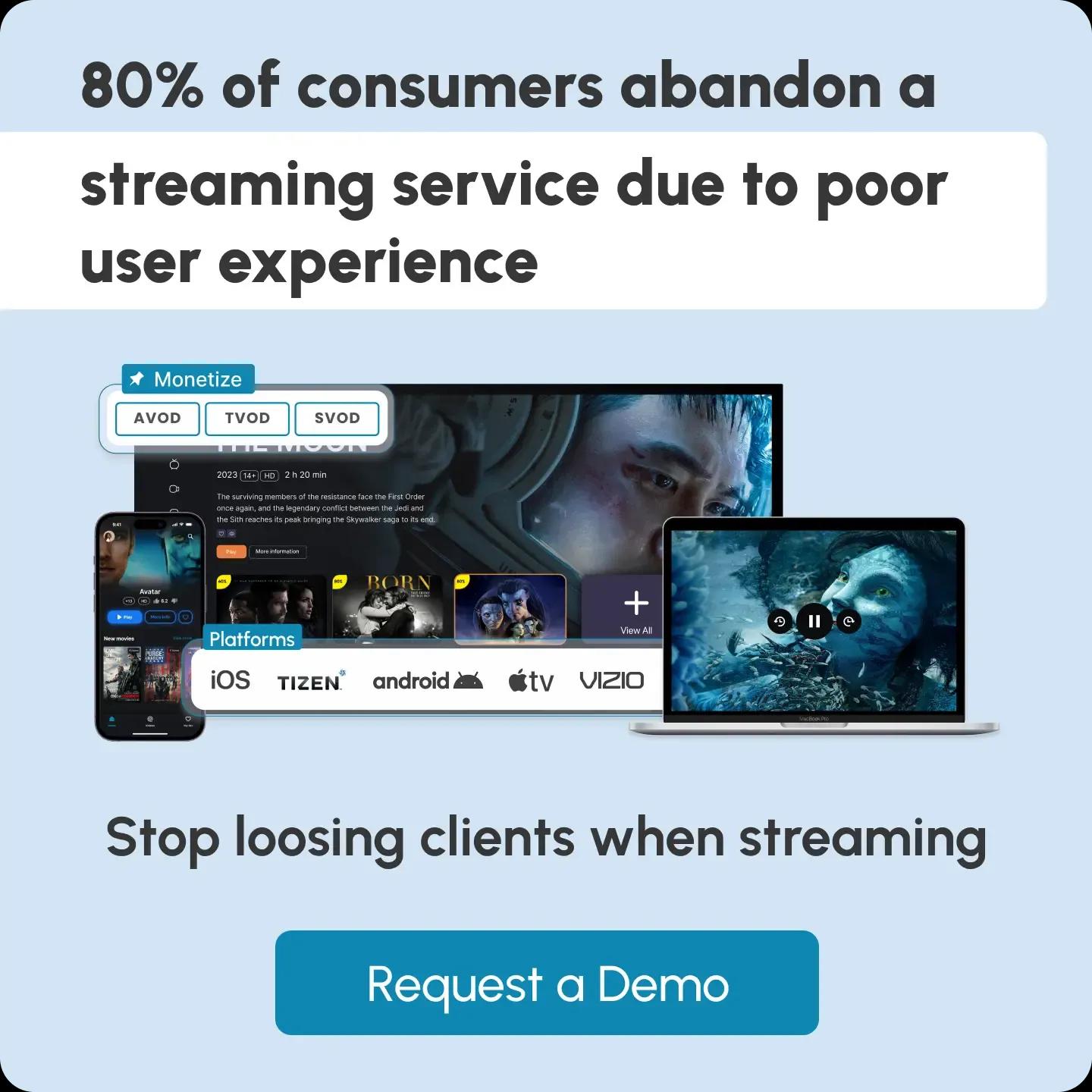
Best Practices for Streaming Advertising: Strategies and Tips
Personalization is the key to successful streaming advertising—when ads align with viewer interests, engagement and conversions skyrocket. With more users shifting to platforms like Netflix, YouTube, Spotify, and Hulu, you can use advanced targeting and interactive formats to deliver personalized, high-impact ads.
This guide breaks down what streaming advertising is, the different ad formats, key benefits, monetization models, best practices, and how to measure success.

What is Streaming Advertising?
Streaming advertising delivers digital ads via the internet across various streaming platforms, including [video-on-demand VOD, live streaming, and audio streaming services.
With this method of advertising you can use highly targeted and interactive ad formats and engage your audience more effectively than with traditional advertising.
Streaming advertising is widely used on top OTT platforms like Netflix, YouTube, Spotify, and Twitch, reaching users across smart TVs, smartphones, tablets, and computers. Unlike traditional TV ads, advertising via streaming services enables you to target audiences based on demographics, behavior, and viewing preferences, ensuring more relevant and impactful messaging.
The 6 Types of Streaming Advertising
1. Video Ads
Video ads are the most popular form of streaming video advertising, appearing before, during, or after content.
Types include:
- Pre-roll ads: Play before the content starts.
- Mid-roll ads: Appear in the middle of the content.
- Post-roll ads: Shown after the content ends.
- Bumper ads: Short, unskippable ads (4-6 seconds long) designed for quick engagement.
Platforms like YouTube, Hulu, and Twitch frequently use these ad formats to deliver targeted messaging.
2. Audio Ads
Streaming audio advertising plays ads between songs or during podcast breaks, making it a key format for advertising on streaming services like Spotify and Pandora. These ads effectively reach audiences who consume content through music and spoken-word platforms.
3. Display Ads
Display ads are non-intrusive banners that appear while users stream content. They typically have smaller dimensions and don’t disrupt the viewing or listening experience, making them a subtle but effective form of streaming media advertising.
4. Interactive Ads
These ads encourage viewer engagement by allowing users to perform an action, like clicking, taking a quiz, or learning more details. The process of advertising on streaming platforms is becoming more dynamic with these interactive elements. They’re also popular since they improve engagement rates and drive user actions.
5. Native Ads
Native ads blend seamlessly with content, making them less disruptive and more engaging. A typical example is a podcast host mentioning a brand naturally during an episode, which is a widely used format in streaming services advertising.
6. Dynamic Ad Insertion (DAI)
DAI delivers highly personalized ads based on the viewer’s profile, ensuring more relevant and effective advertising on streaming platforms. This technology allows brands to insert targeted ads in real-time for maximum engagement and higher conversion rates.
The Benefits of Streaming Advertising
 Streaming service advertising offers several advantages that make it a powerful tool for your streaming business. Let’s have a look at some of them.
Streaming service advertising offers several advantages that make it a powerful tool for your streaming business. Let’s have a look at some of them.
Wider Reach
Streaming services have become a dominant force in media consumption. In September 2024, streaming accounted for over 43% of total TV usage in the United States, surpassing traditional cable and broadcast viewing.
Advanced Targeting
Advertising on streaming platforms allows for precise audience targeting. Platforms collect detailed user information, like demographics, interests, and behavior. Advertisers can then leverage this data to create more accurate and personalized ad campaigns. In fact, targeted ads are over 5x more effective in increasing click-through rates (CTR).
Cost-Effective Marketing
Compared to traditional TV ads, streaming advertising is much more affordable and can benefit various businesses, no matter the budget. The shift towards ad-supported streaming models also offers cost-effective opportunities for advertisers.
For example, the UK’s streaming advertising market is expected to surpass £1 billion, driven by platforms like Netflix introducing ad-supported tiers, which makes advertising more accessible to a vast range of businesses.
Data-Driven Performance Measurement
Streaming advertising offers powerful analytics, allowing advertisers to track performance with precision. Key metrics such as impressions, click-through rates (CTR), and conversions provide real-time insights, enabling brands to optimize campaigns for maximum impact.
With advanced video streaming performance metrics, advertisers can measure audience engagement, refine targeting strategies, and improve their returns on investment (ROI).
Personalized Experience
With technologies like Dynamic Ad Insertion (DAI), advertisers can deliver highly personalized ads tailored to user preferences, viewing habits, and demographics. This level of customization boosts engagement, improves relevance, and significantly boosts conversion rates.
Multi-Device Compatibilities
One of the biggest perks of streaming media advertising is its ability to reach audiences no matter their device. Streaming ads can follow viewers wherever they watch, whether it's a smart TV, smartphone, tablet, or laptop. In 2024, 62% of U.S. viewers streamed video on their smart TVs weekly, up from 47% in 2021.
Over-the-top or OTT streaming is enormous, too. By 2025, 58% of digital video viewers (about 2.25 billion people!) will use paid subscription-based OTT services.
Meanwhile, 79% of U.S. households own a smart TV, making CTV advertising more relevant than ever.
With more people streaming content across multiple devices, advertising on streaming platforms allows you to connect with your audience anytime, anywhere.
Monetization Models in Streaming Advertising
 Depending on your goals, you can choose from several streaming advertising monetization models. Here’s a quick rundown of the most popular ones:
Depending on your goals, you can choose from several streaming advertising monetization models. Here’s a quick rundown of the most popular ones:
Subscription-Based Advertising (SVOD)
SVOD advertising is commonly used on platforms that charge a subscription fee from users and integrate a limited number of ads into the content. It allows advertisers to reach premium audiences while ensuring a smooth, non-intrusive user experience.
Ad-Supported Video-on-Demand (AVOD)
Platforms like YouTube and Tubi use this type of monetization model. With AVOD, viewers have free access to content, but ads generate the platform’s revenue. This approach allows advertisers to reach massive audiences at no cost to the viewer.
Transactional Video-on-Demand (TVOD)
Also known as pay-per-view (PPV), the TVOD model is used by platforms like Amazon Prime Video, where users can rent or buy content while seeing ad-supported options. Advertisers benefit from targeting users who are highly engaged with specific content, while platforms generate revenue from both ads and transactions.
Freemium Advertising
Freemium advertising is a hybrid model that combines free ad-supported content with a premium ad-free experience. Spotify is a great example—users can choose between a free version with ads or a paid, uninterrupted listening experience. This gives advertisers access to free-tier users while offering an upsell to premium subscribers.
Best Practices for Effective Streaming Advertising
Want to get the most out of streaming media advertising? Follow these key best practices to maximize effectiveness and engagement.
Understand Your Audience
Start by gathering detailed insights into your target audience’s demographics, interests, and streaming habits. Adjust your ads based on user preferences, behaviors, and needs. For example, platforms like YouTube and Spotify offer robust targeting tools. The more personalized your approach, the better the engagement.
Adjust with the Platform
Each streaming platform has a unique audience and content format. To get better results, tailor your ads accordingly. For instance:
- YouTube: Pre-roll and mid-roll video ads perform best.
- Spotify: Audio ads are more effective.
- OTT and CTV platforms: A mix of pre-, mid-, and post-roll ads, as well as non-skippable ads, can work well.
Keep Ads Short and Engaging
Short, attention-grabbing ads drive better engagement and reach. That’s why 15-30 second ads typically perform best. Use clear messaging, strong visuals, and a compelling call-to-action (CTA). It’s also a good idea to hook viewers within the first 5 seconds to prevent drop-off.
A/B Test Your Ads
Test different ad formats, visuals, messaging, and CTAs to see what resonates best with your audience. For example, you can experiment with different tones of voice (formal vs. conversational) visual styles (animated vs. live action), and CTA placements (beginning vs. end).
Optimize for Multiple Devices
Streaming happens across smart TVs, smartphones, tablets, and desktops. Make sure your ads are formatted properly for different screen sizes. They should also have clear visuals and text for smaller mobile screens. Similarly, include mobile-friendly CTAs (e.g., “Tap to Learn More” instead of “Click”).
Measurement and Analytics
Succeeding in on-demand and live-streaming marketing goes beyond crafting engaging ads. You must also track performance, analyze data, and refine your strategy in real-time. To drive the best results, focus on these key components:
Track Essential Metrics
Wondering if your streaming advertising strategy is working? Keep an eye on these key performance indicators (KPIs):
- Reach and Impressions: How many people saw your ad.
- Click-Through Rate (CTR): The percentage of viewers who clicked on it.
- Video Completion Rate (VCR): How often people watched it to the end.
- Cost Per Thousand Impressions (CPM): The cost to reach 1,000 viewers.
- Cost Per Acquisition (CPA): How much you spend to get a conversion.
- Return on Investment (ROI): The ultimate measure of your campaign’s success.
By tracking these numbers, you’ll see what’s working, what’s not, and where to improve.
Leverage Attribution Models
Not all ad interactions are created equal. Attribution models help you figure out which ad interactions actually drive conversions. Here are the most common types:
- First-Click: Gives credit to a user's first interaction with your ad.
- Last-Click: Attributes the conversion to the last ad interaction before purchase.
- Linear: Spreads the credit evenly across all interactions.
- Time-Decay: Prioritizes more recent interactions over earlier ones.
Choosing the right attribution model helps you understand where your streaming ads are making the most significant impact—and where you should invest more.
Use Real-Time Analytics for Instant Optimization
The beauty of streaming advertising is that you don’t have to guess what’s working. You can track it in real time. Platforms like inoRain offer advanced analytics dashboards, helping you:
- See what’s resonating with your audience.
- Adjust ad placements for better engagement.
- Optimize campaigns in real time for maximum ROI.
With real-time advanced analytics, you can fine-tune your campaigns instantly, responding to audience behavior and market trends as they evolve.
inoRain’s comprehensive analytics dashboard helps you track key performance metrics, optimize ad placements, and make data-driven decisions with confidence. For these and the rest of your OTT business needs, contact us to level up your OTT business.
The Future of Streaming Advertising
The future of streaming advertising is exciting and full of positive changes. Here are some key trends that are already changing the way advertisers and brands connect with audiences:
AI-Driven Hyper-Personalization
With the help of AI and predictive analytics, ads will become even more effective, personalized, and engaging. Additionally, streaming services will collect deeper insights into viewer behavior, allowing advertisers to create hyper-personalized ads that align with user interests. AI-driven audience targeting has already led to a 30% increase in ad performance and a 25% reduction in costs. The more relevant the ad, the higher the chance of conversion.
Interactive and Shoppable Ads
Ads are moving beyond passive viewing. In fact, one study found that 75% of viewers said they’d pay more attention to an interactive ad than a traditional one. In another survey, 80% of respondents said they’d take action when exposed to an interactive ad. So, expect more interactive elements like clickable links, QR codes, and CTA buttons like "shop now" and "learn more" that allow viewers to view products or services right within the ad.
These innovations make ads more engaging and action-driven, allowing businesses to connect with potential customers in real time. Plus, they provide valuable data on user interactions, which helps brands refine their targeting and measure ad effectiveness more precisely.
VR and AR Ads
New technologies, such as virtual reality (VR) or augmented reality (AR), will also play a big role in the future of advertising. Just imagine being able to virtually try on clothes with an ad or see how furniture would look in your house. These advanced experiences will make ads more fun, practical, and engaging. Despite slow adoption, 35% of consumers are more likely to make a purchase after seeing a VR ad.
Greater Focus on Privacy and Transparency
With stricter data privacy regulations, advertisers will need to be more transparent about what data they collect and how it’s used. Striking the right balance between personalization and privacy will be key to earning consumer trust while delivering effective ads. One emerging solution is zero-party data collection, where consumers voluntarily share their information. This approach promotes a more ethical and transparent exchange, allowing brands to create personalized experiences without violating privacy concerns.
Who Can Use Streaming Advertising?
Any business, big or small, can leverage streaming ads, even on a tight budget.
With AI and advanced technology, ads are becoming more personalized, interactive, and effective. At the same time, privacy and transparency are key to building audience trust. By understanding how streaming platforms work and applying best practices, brands can maximize reach, engagement, and ROI.
Looking to launch your own streaming platform? inoRain provides custom-branded OTT platforms with advanced built-in analytics tools for content creators, businesses, and TV operators. You are given complete control over your content, monetization options, and audience. Get in touch with our experts if you want to know more!
Frequently Asked Questions
Founder / CEO
Andranik is the CEO and Co-Founder of inoRain OTT and the Co-Founder of HotelSmarters, specializing in next-generation streaming technologies and digital transformation for the hospitality sector. He focuses on building innovative, scalable solutions for video delivery, OTT monetization, and data-driven hospitality management. His work bridges technical sophistication with practical business impact, helping organizations modernize their digital ecosystems and improve operational efficiency.

OTT Advertising: Types, Best Practices, and Strategies
Over-the-top (OTT) advertising has transformed how brands connect with consumers.

VPlayed Alternatives: inoRain vs. VPlayed
Explore inoRain as a VPlayed alternative, comparing features, pricing, and OTT solutions to find the best platform for your streaming needs.

Custom OTT Platform Development: How to Start an OTT Business
This guide will walk you through everything you need to know about the OTT platform development.
